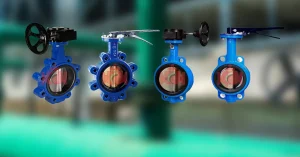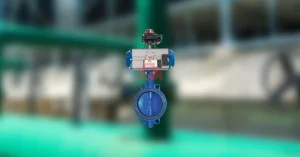Table of Contents
Everything You Need to Know About Manual Butterfly Valves
Manual Butterfly Valves are one of the most versatile and widely used types of valves in the industrial world. Known for their simple design, cost-effectiveness, and ease of operation, they play a vital role in regulating the flow of liquids, gases, and even slurries across a broad range of industries.
Concorde Valves and Automations specializes in delivering high-quality manual butterfly valves that cater to specific needs across sectors such as waterworks, chemical processing, pharmaceuticals, and more. From AWWA C-504 & AWWA C-516 Large Diameter Double Flange Butterfly Valves to Pharmaceutical Application Butterfly Valves, Concorde has solutions engineered for both reliability and performance.
What Are Manual Butterfly Valves?
Manual butterfly valves are mechanical devices used to start, stop, or regulate the flow of a medium through a pipeline. They are operated by hand using a lever, a manual actuator, or a handwheel, which controls the position of a disc within the valve body.
These valves are either fully open (allowing maximum flow) or fully closed (blocking the flow entirely). Variants, such as the Manual UPVC Butterfly Valve, and Aluminum Butterfly Valve Manual, provide flexible options depending on the application and pipeline material.
Components and Materials Used
Manual butterfly valves consist of several key components:
- Body: Houses all internal parts. Available in materials such as cast iron, stainless steel, or aluminum (e.g., Manual Aluminum Butterfly Valve).
- Disc: A rotating element that regulates flow. Common disc types include triple eccentric or double eccentric designs, such as the Double Eccentric Offset Disc Wafer Type Butterfly Valve.
- Stem: Connects the actuator to the disc, enabling rotation.
- Seat: Creates a seal between the body and disc to prevent leakage. Options include Metal & Soft Seated Butterfly Valve and PTFE-lined variants like the PTFE Sleeve Butterfly Valve or FEP PFA Lined Butterfly Valve.
- Manual Actuator: Operates the valve by hand, often enhanced with features like limit switches for feedback (e.g., Manual Butterfly Valve with Limit Switch).
How Manual Butterfly Valves Work
The operation of manual butterfly valves is pretty straightforward. When the lever, handwheel, or actuator is turned, the valve stem rotates the disc.
- Open Position: The disc aligns parallel to the flow, allowing an unobstructed passage.
- Closed Position: The disc is perpendicular to the flow, sealing off the medium.
Optimized models, such as the Triple Eccentric Wafer Type Butterfly Valve Metal & Soft Seated, are widely used in scenarios requiring pressure tolerance and precise flow control.
Advantages and Disadvantages of Manual Butterfly Valves
Advantages
- Cost-Effective: Simple design and minimal material usage make them an economical choice.
- Compact Design: Space-saving when compared to other valve types.
- Wide Range of Applications: From Manual Exhaust Butterfly Valves to Rubber Lined Wafer Type Butterfly Valves, the usability is extensive.
- Ease of Maintenance: Accessible components ensure repairs are efficient using a standard Butterfly Valve Operation and Maintenance Manual.
Disadvantages
- Pressure Drop: The disc remains in the flow even when open, causing some pressure loss.
- Limited High-Pressure Capability: While advanced designs like the Double Eccentric High Performance Butterfly Valve improve this, it remains a consideration.
Applications Across Industries
Manual butterfly valves demonstrate their versatility by being employed in diverse industries including:
1. Water Treatment and Distribution
- Ensures smooth flow in municipal pipelines. Rubber Lined AWWA C 504 Double Flange Butterfly Valve excels in this domain with its short pattern design.
2. Chemicals
- Corrosive materials handled with PTFE-lined solutions like the Pneumatic PTFE Sleeve Butterfly Valve.
3. Pharmaceuticals
- Sterile and contamination-free operations, using Pharmaceutical Application Butterfly Valves.
4. Cement and Construction
- Used to manage slurries and abrasive material, supported by the Manual Butterfly Valve for Cement.
Selecting and Installing Manual Butterfly Valves
- Material Compatibility: Ensure the valve’s material corresponds to the fluid’s composition. Use options like Double Flange Fabricated Damper Valve for high-stress environments.
- Valve Size: Reference sizes such as Manual Wafer Butterfly Valve DN150 for accurate dimension matching.
- Application-Specific Design: For precision, consider valves like the Vanessa Butterfly Valve Manual for sensitive systems.
Installation Tips:
- Follow a Butterfly Valve Manual Actuator guide to correctly mount and test.
- Ensure alignment along the pipeline to avoid leaks and improper disc movement.
Maintenance and Care Guidelines
Proper maintenance contributes to long-lasting valve performance. Follow these tips for optimal results:
- Regular Cleaning: Clear debris buildup, especially for valves in abrasive applications like Manual Exhaust Butterfly Valves.
- Lubrication: Routine lubrication ensures smooth disc motion, as outlined in the Butterfly Valve Operation and Maintenance Manual.
- Visual Inspections: Check for wear and tear on gaskets, seals, and the disc’s surface.
Regular upkeep makes models like the Rubber Lined Wafer Type Double Flange Butterfly Valve suitable for rigorous industrial processes.
What Lies Ahead for Manual Butterfly Valves
Manual butterfly valves, including advanced options from Concorde Valves and Automations, are continuously evolving. Emerging designs improve durability, compatibility, and precision for the strict demands of modern industries.
For businesses in need of cost-effective and reliable flow control solutions, these valves represent an evergreen choice. Explore the range of manual operated butterfly valves and other innovative designs from Concorde Valves and Automations today to unlock unparalleled efficiency.
Manual Butterfly Valves

Manual butterfly valves are key components in modern industrial systems, offering precise flow control and seamless operation. Designed for versatility, they are used across industries like oil and gas, water treatment, and chemical processing. Concorde Valves features durable designs, including PTFE Sleeve and Triple Eccentric, ensuring efficiency and reliability.
Product Brand: Concorde Valves and Automations
Product Currency: INR
Product In-Stock: InStock
5




